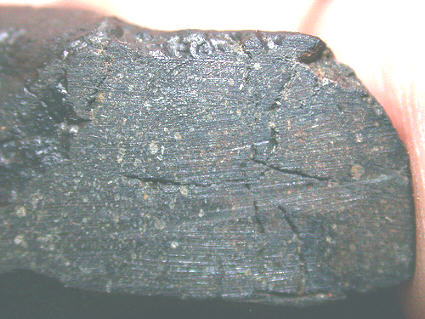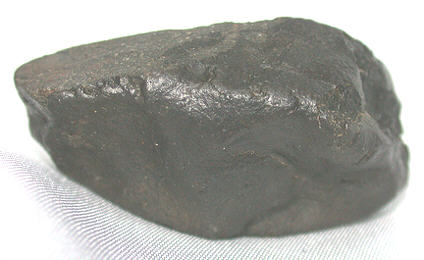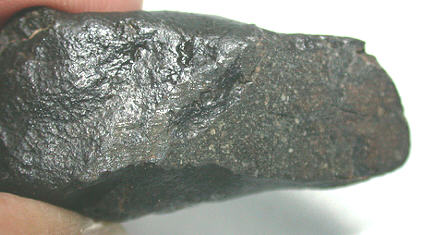NWA 4765
CM1
(CM2.0; Rubin et al., 2007) 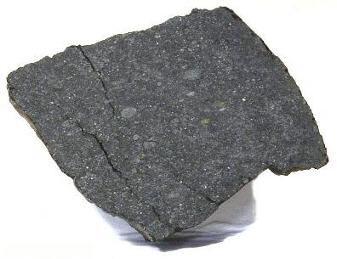
click on photo for a magnified view Purchased 2006
no coordinates recorded A single, partially crusted meteoriteWork in progress. A solid natural object reaching a planet’s surface from interplanetary space. Solid portion of a meteoroid that survives its fall to Earth, or some other body. Meteorites are classified as stony meteorites, iron meteorites, and stony-iron meteorites. These groups are further divided according to their mineralogy and Click on Term to Read More fragment weighing 42 g (19 g recorded for NWA-series designation) was found in Northwest Africa, and a portion was sold through A. Habibi to meteorite collector S. Ralew in Erfoud, Morocco. A type specimen was submitted for analysis and classification to the Museum für Naturkunde (A. Greshake and M. Kurz), and it was determined that NWA 4765 is a CM1 carbonaceous chondriteCarbonaceous chondrites represent the most primitive rock samples of our solar system. This rare (less than 5% of all meteorite falls) class of meteorites are a time capsule from the earliest days in the formation of our solar system. They are divided into the following compositional groups that, other than Click on Term to Read More, the first of its kind to be found outside of Antarctica. An analysis of the O-isotopes was conducted by the Open University (Franchi and Greenwood).
- hydrationReaction of a substance with water. Click on Term to Read More of fine-grained matrix material to form phyllosilicates, which gradually consists of Mg-rich serpentines
- conversion of primary igneous glass in chondrules to phyllosilicate
- production of large PCP clumps, now determined to be tochilinite–cronstedtite intergrowths (TCI)
- precipitation of sulfides within cavities
processes occurring throughout the alteration sequence:
- oxidationOxidation and reduction together are called redox (reduction and oxidation) and generally characterized by the transfer of electrons between chemical species, like molecules, atoms or ions, where one species undergoes oxidation, a loss of electrons, while another species undergoes reduction, a gain of electrons. This transfer of electrons between reactants Click on Term to Read More of FeNi-metal
- alteration of chondrule mafic phenocrysts
- compositional changes in TCI; e.g., S depletion
- formation of increasingly complex carbonates within sulfide-lined cavities
- compositional changes in sulfides
- replacement of primary melilite by secondary alteration products
- fragmentation/disintegration of refractory inclusions
An aqueous alteration sequence for some CM group members from most to least aqueously altered follows (Rubin et al., 2007): MET 01070 [2.0] LAP 02277 [2.0] QUE 93005 [2.1] Cold Bokkeveld [2.2] Nogoya [2.2] QUE 99355 [2.3] Mighei [~2.3] Y-791198 [2.4] Murray [2.4/2.5] Murchison [2.5] Kivesvaara [2.5] QUE 97990 [2.6] Representatives of the earliest stages of aqueous alteration (2.9–2.7) on the CM parent body have not yet been discovered, although the unaltered, type CM3.0 precursor material was probably similar to the ungrouped (probably CO-related; Simon and Grossman, 2015) Acfer 094. See the Colony page for further details about a potential genetic relationship between the CM and CO groups.
Current studies suggest that both cometary dust and meteorites should be produced from the disruption of Jupiter-family comets which originate in the Kuiper beltRegion in the outer solar system beyond Neptune's orbit that contains billions of small, icy planetesimals from the original protoplanetary disc that failed to coalesce into planets. The Kuiper Belt extends from Neptune's orbit at 30 AU to ~55 AU. It is ~20x wider and 20-200x more massive than the Click on Term to Read More. Studies have shown that Antarctic micrometeorites have a similar carbonaceous chondriteChondrites are the most common meteorites accounting for ~84% of falls. Chondrites are comprised mostly of Fe- and Mg-bearing silicate minerals (found in both chondrules and fine grained matrix), reduced Fe/Ni metal (found in various states like large blebs, small grains and/or even chondrule rims), and various refractory inclusions (such Click on Term to Read More:ordinary chondriteWork in Progress Ordinary chondrites (OCs) are the largest meteorite clan, comprising approximately 87% of the global collection and 78% of all falls (Meteoritical Society database 2018)1. Meteorites & the Early Solar System: page 581 section 6.1 OC of type 5 or 6 with an apparent shock stage of S1, Click on Term to Read More ratio ((~7:1) as the composition of zodiacal dust (Meier, 2014). Based on observational evidence and current modeling, it is thought that comets should be dark in color and have a low densityMass of an object divided by its volume. Density is a characteristic property of a substance (rock vs. ice, e.g.). Some substances (like gases) are easily compressible and have different densities depending on how much pressure is exerted upon them. The Sun is composed of compressible gases and is much Click on Term to Read More and strength, a high porosityThe volume percentage of a rock that consists of void space. Vesicular porosity is a type of porosity resulting from the presence of vesicles, or gas bubbles, in igneous rock such as the pumice presented here. Vesicular porosity is very rare in meteorites and is often associated with slag, one Click on Term to Read More, a solar ratio of elements, an elevated ratio of C, H, O, and N, a high interstellar grain content, anhydrous and highly unequilibrated silicates, few to no chondrules, and a low cosmic-ray exposure ageTime interval that a meteoroid was an independent body in space. In other words, the time between when a meteoroid was broken off its parent body and its arrival on Earth as a meteorite - also known simply as the "exposure age." It can be estimated from the observed effects Click on Term to Read More (<10 m.y.). Both the CI and CM groups of meteorites exhibit characteristics that are consistent with the above descriptions. Orbital data obtained from several carbonaceous chondrites (e.g., CI OrgueilA large carbonaceous Ivuna-like (CI1) chondrite that disintegrated and fell in fragments near the French town of Orgueil on May 14, 1864. About 20 pieces, totaling ~12 kg in mass, were subsequently recovered from an area of several square km, some head-sized but most were smaller than a fist. Specimens Click on Term to Read More [eyewitness plotting]; CMs Maribo and Sutter’s Mill [instrument recording]) are a good match to the orbits expected from the disruption of Jupiter-family comets, but are unlike the orbits of ordinary chondrites and most other asteroidal objects (Meier, 2014). Both the orbital eccentricityThe deviation of an orbit from circularity. Circles have eccentricities of 0. Click on Term to Read More and semimajor axis for Maribo is nearly identical to those of CometConglomeration of frozen water and gases (methane, ammonia, CO2) and silicates that that formed in the outer solar system and orbits the Sun. In recent years, the description of comets has shifted from dirty snowballs to snowy dirtballs with more dust than ice. However, the ratio is less than 10-to-1. Click on Term to Read More Encke and the associated Taurid swarm of objects (Haack et al., 2011). On the other hand, a CRE age study of CM chondrites conducted by Meier et al. (2016) shows a possible relationship exists to the asteroid breakup event ~8.3 m.y. ago that formed the Ch/C/Cg-type members of the Veritas family. In addition to the large abundance of 3He-enriched interplanetary dust discovered in 8.2 m.y.-old deep-sea drill cores, ~1/6 of all CM meteorites have 21Ne-based CRE ages that are consistent with derivation from this catastrophic breakup, while others with significantly younger CRE ages could represent secondary collisions among the Veritas fragments. Based on reflectance spectra in the range of 0.4 to 2.4 μm captured by the OSIRIS-REx spacecraft, as well as utilizing meteorite analogs, it has been speculated that asteroid (101955) 1999 RQ36 is composed of CM1-like material. Further details of the formation of CM chondrites can be found on the Murchison page. The specimen of NWA 4765 shown above is a 0.8 g partial slice. A photo of the main massLargest fragment of a meteorite, typically at the time of recovery. Meteorites are commonly cut, sliced or sometimes broken thus reducing the size of the main mass and the resulting largest specimen is called the "largest known mass". Click on Term to Read More is shown below.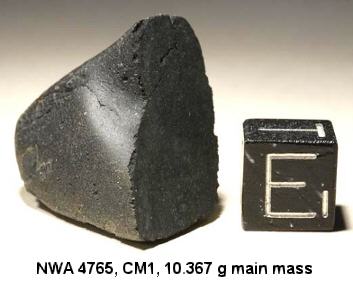
Photo courtesy of Chladni’s Heirs—S. Ralew & M. Altmann Photos shown below courtesy of Aziz Habibi
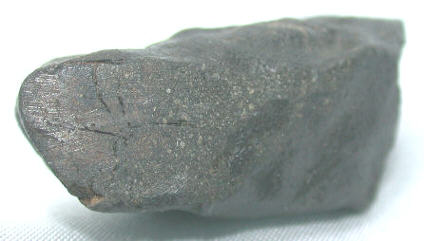
click on photo for a magnified view
